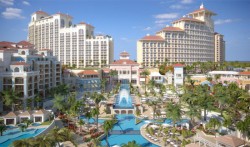Hosted by the Grand Bahama Human Rights Association (GBHRA) and Save Guana Cay Reef (SGCR) Association, the unique one-day assembly was held at the Westin and Sheraton at Our Lucaya on Saturday.
Both associations organized the meeting of delegates from throughout The Bahamas who represent Family Island communities trying to promote and save their local rights, traditions, culture, land and marine environments.
The conference featured an extensive list of speakers, each a leading authority and recognized in his or her field.
These included scientists, marine biologists and officials from non-governmental organizations ヨ local and from abroad ヨ all of whom are concerned with local rights and protecting the marine and land environment.
There were representatives from Andros, New Provi-dence, The Abacos, Bimini, Eleuthera, Mayaguana and Grand Bahama.
Also in attendance were Dr. James Cervino, Dr. Thomas Goreau, wetlands restoration specialists, dive operators, anong others.
Erica Gates, owner and operator of Grand Bahama Nature Tours, addressed the enthused room on preserving The Bahamas’ terrestrial ecosystems as well as its marine ecosystem.
“What I tried to share with the group was the six diverse ecosystems that occur on Grand Bahama island because I know we always give priority to the marine ecosystems, but the land-based or terrestrial ecosystems are just as beautiful and worth preserving,” she said.
Gates took those in attendance on a virtual tour from the south shore to the north shore of the island, which gave them the opportunity to look at some flora and fauna.
Other speakers included Jermaine Johnson, an eco-activist from San Salvador, and SGCR President Troy Albury, who shared experiences of similar challenges faced on their small islands with major development projects.
The conference closed with a presentation by GBHRA President Fred Smith, who addressed the importance of local rights.
“We have to remember that The Bahamas is an archipelago of small islands and we have a very fragile ecosystem and its important that we have development for jobs and business opportunities for Bahamians,” he said. “But at the same time we have to ensure that growth is sustainable and environmentally sensible.”
Smith explained that there are two broad legal strategies that might be pursued to seek to prevent or mitigate a proposed development or its scale.
“First, there are a number of public law challenges that might be made in respect of various statutory central and local government approvals for developments,” he said. “Second, there are a number of private law challenges that might be made by nearby residents and landowners concerned about the effect developments would have on their property.”
With this Smith went on to discuss his ongoing Save Guana Cay court battle.
“Save Guana cay Reef Association is a company formed by some of the residents and landowners of Great Guana Cay for the specific purpose of challenging the proposed development of a major residential and hotel project, together with a marina and golf course, at Great Guana Cay in Abaco, Bahamas, the Development,” he said.
The association was established to represent the interests of the local residents and landowners who would be affected by the development.
“The government purported to enter into a Heads of Agreement, giving permission for the development, and agreeing to grant leases of crown and treasury land on which it was to be developed, dated March 1,2005,” he added. “It is the entering into of the Heads of Agreement which is the subject of judicial review proceedings in the Supreme Court.”
Smith contends that the Heads of Agreement purports to bind “the Government” to its terms, and is intended to constitute a binding contract between the developers and the Government of the Bahamas.
By ANGELO ARMBRISTER, Freeport News Reporter



